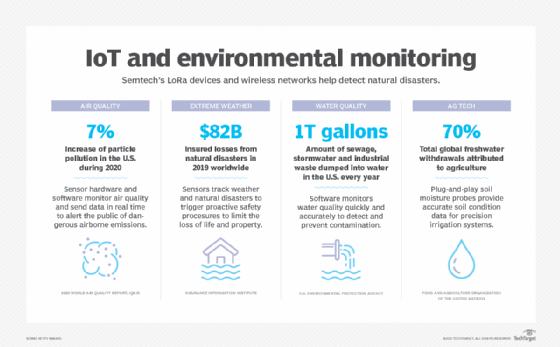
Getty Images
IoT technology can advance environmental monitoring
LPWAN and IoT sensors help manufacturers, developers and organizations address environmental climate concerns with connected applications and streams of real-time data.
Environmental dangers are a global concern, and individuals, municipalities and organizations alike are making a conscious effort to reduce waste, minimize their environmental footprint and promote overall sustainability. Whether it's flooding, poor air quality or radiation leaks, the ability to monitor and detect environmental issues in real time is essential.
Decentralized wireless networks based on low-power WAN (LPWAN) connectivity makes connected device design easier and enables seamless environmental monitoring. For IoT-enabled sensors, LPWAN connectivity supports various capabilities at reduced connectivity costs compared to cellular and incentivizes individuals to deploy compatible hotspots, which can eventually provide coverage for hundreds of square miles. Capabilities include the following:
- Frictionless onboarding. Deploy multiple devices without additional configurations or third-party assistance.
- Roaming. Send data through any hotspot by mapping to a company identification on the blockchain.
- Micropayment transactions. Earn cryptocurrency when devices transfer data through a hotspot.
- Blockchain integration. Issue a cryptographic notary for audit trails as transaction data from devices are added to the blockchain.
The effects LPWAN networks can have on the environment is undoubtedly a critical piece of the puzzle when looking for environmental monitoring solutions. Long-range, low-power capabilities can enable hotspot owners the ability to monitor the environment and make proactive decisions based on the collected data.
With IoT-enabled sensors, owners can better monitor and manage air quality with real-time data and, therefore, alert the public of dangerous airborne emissions, as well as, in turn, help local government officials make decisions that positively affect residents.
According to the National Oceanic and Atmospheric Administration: "In 2021 (as of Oct. 8), there have been 18 weather/climate disaster events with losses exceeding $1 billion each to affect the United States."
These natural disasters -- flooding, wildfires, droughts and everything in between -- significantly affect the climate and the nation's infrastructure. IoT-enabled technology can help monitor and alert information on how conditions are changing. Collected data can better inform experts to make better predictions and forecasting to keep citizens safe.
A framework that combines IoT-enabled sensors with a distributed, open source approach to build ubiquitous networks enables any manufacturer, developer or application to use LPWAN-compatible technology to connect devices across the nation and inform decision-making that can positively affect the environment.

Marc Pégulu has been vice president of IoT in the wireless and sensing products group at Semtech since June 2015. Pégulu joined the company in March 2006 and was involved in several key technology initiatives, including LoRa wireless and software-defined modem technologies. Prior to joining Semtech, he held positions in chips and systems development at Thomson CSF, Thales, Atmel and DiBcom in France and China.






